As neither patterned fabric nor bold contrast were exactly popular last week, this week I’ve picked something completely different: a monochrome Empire era dress that would be boring, except for subtle details that set it apart.
Last Week: an 1890s day dress with all the trimmings
Whatever you saw in last week’s Rorschart test of a dress, it certainly gave you something to talk about. It’s the first Rate the Dress in quite a while to break 50+ comments! Some of you thought it was way, way too much (Lynne said her eyes felt they needed a lie down after looking at it). Others loved how bold it was, how unafraid to really embrace the trends of the time. And some of you were weirded out by the ground fabric, particularly in combination with the strong red velvet.
However you felt about it, you felt about it strongly. I don’t think we’ve ever had quite so many 2s and 10s all on the same Rate the Dress!
The Total: 6 out of 10
If you goal in this dress was to be admired by all, you wouldn’t succeed. But if your goal was to be memorable and talked about, well, sartorial mission accomplished!
This week: an Empire era dress with subtle hues and subtle ruffles.
After last week’s dress, I thought I’d better show something restful and muted. And you can’t really get any more muted than this pale mouse grey silk frock, or any simpler than a Regency sheath. But this dress isn’t quite as simple as it looks: it has a number of secrets.
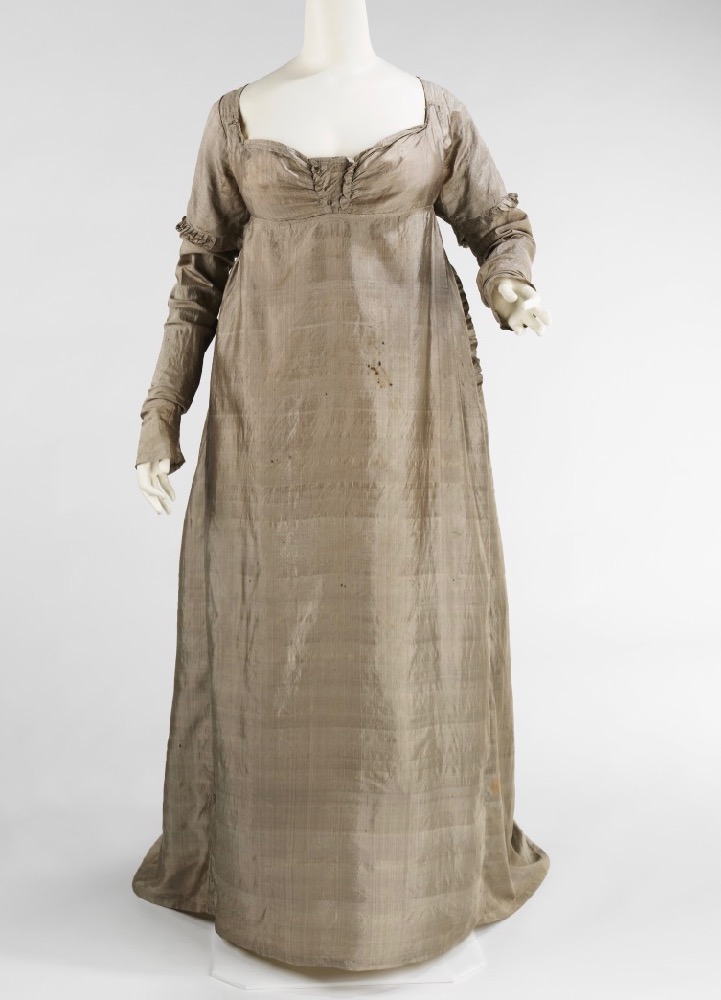
First, the colour. It’s possible that the grey-brown hue is very close to the dresses original colour: just a tiny bit faded with time. But the shade of the dress is also one that a number of the more unstable dye colours fade to.
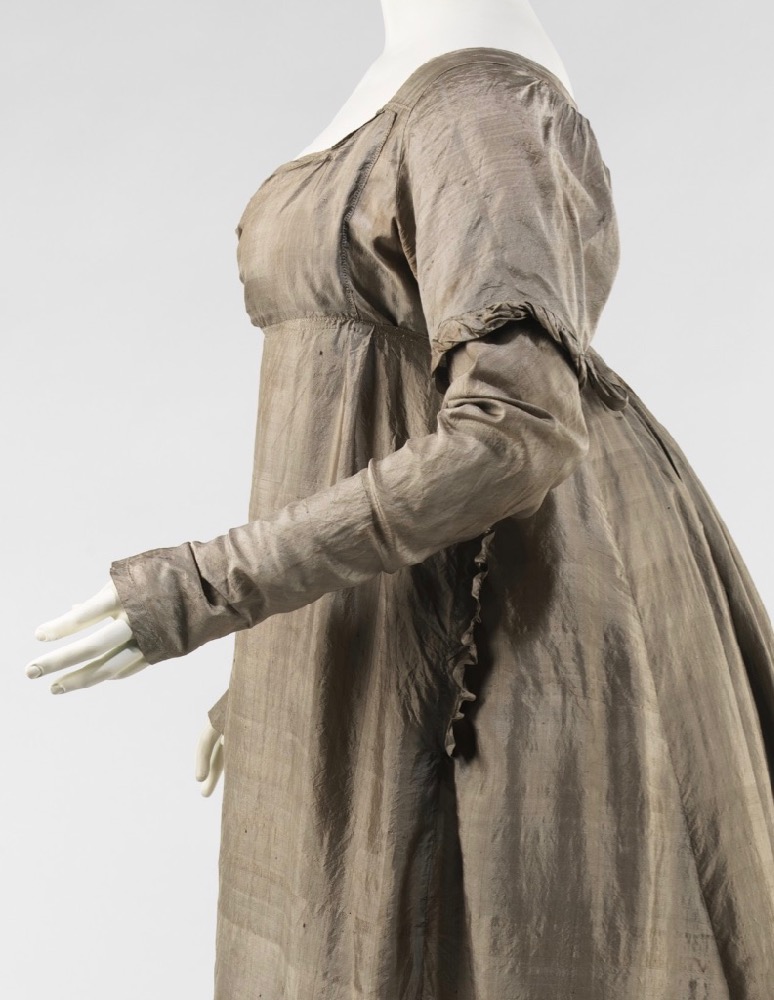
Certain black dyes (like the ones used to quickly dye Queen Victoria’s ‘Privy Council’ mourning dress when she inherited the throne three decades later) can fade to this colour, as will some purples, some richer browns, and some blues. So this dress may not have been quite as subtle in its original incarnation.
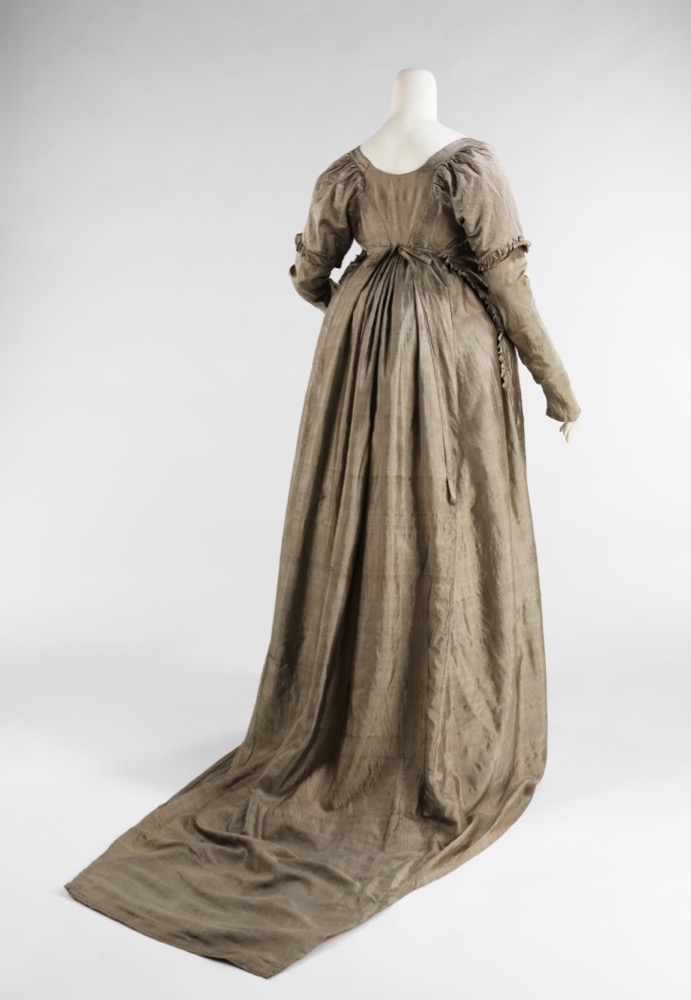
Nor is it quite a boring, bog-standard high-waisted, classically inspired Empire Era dress: it has a few details that set it apart, like the squared off train.
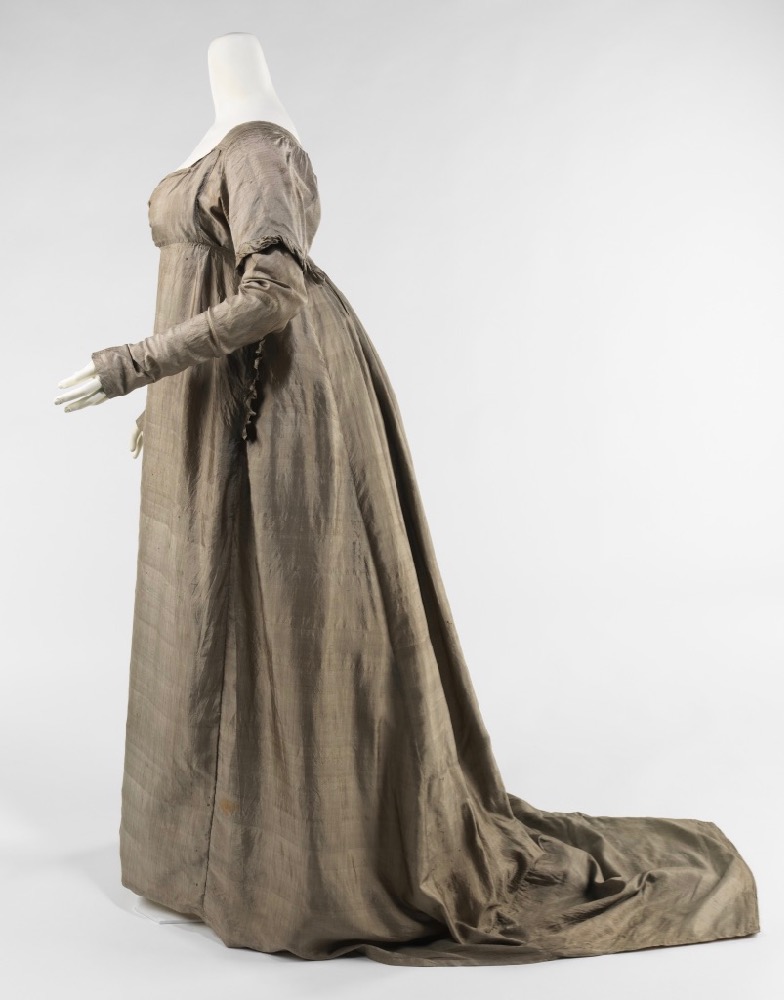
And the tiny ruffled details that tie together the oversleeves (the dress can almost certainly be worn with short short sleeves as well as with the long undersleeves), the bodice detailing, and the slits of the apron front.
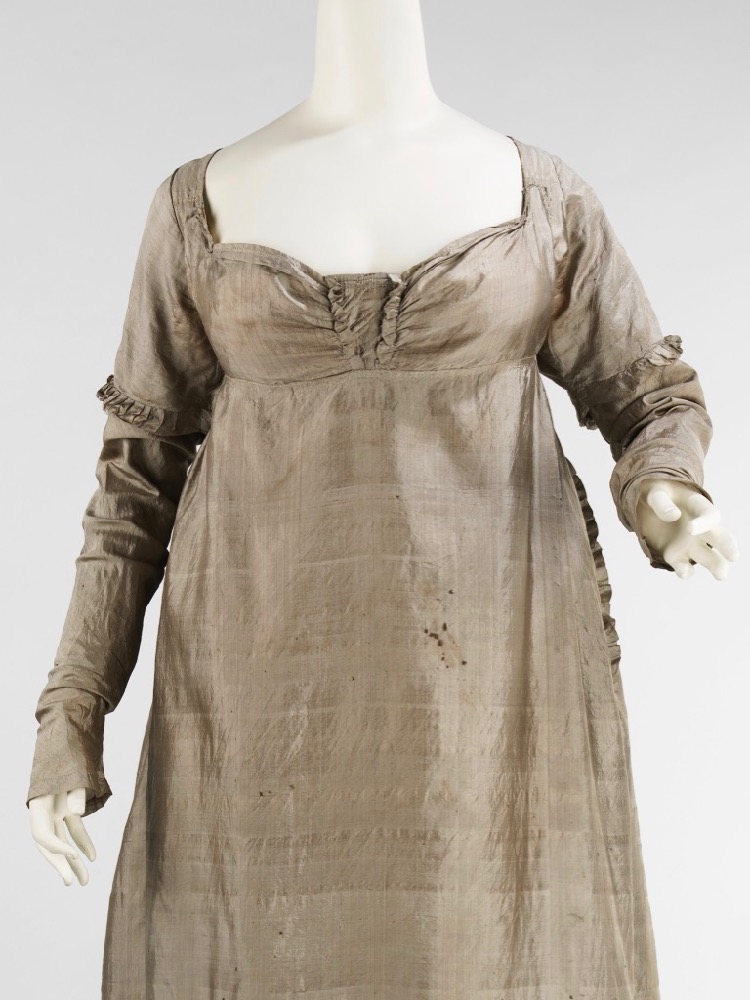
You can just see the ruffled detail of the apron-front slits here:
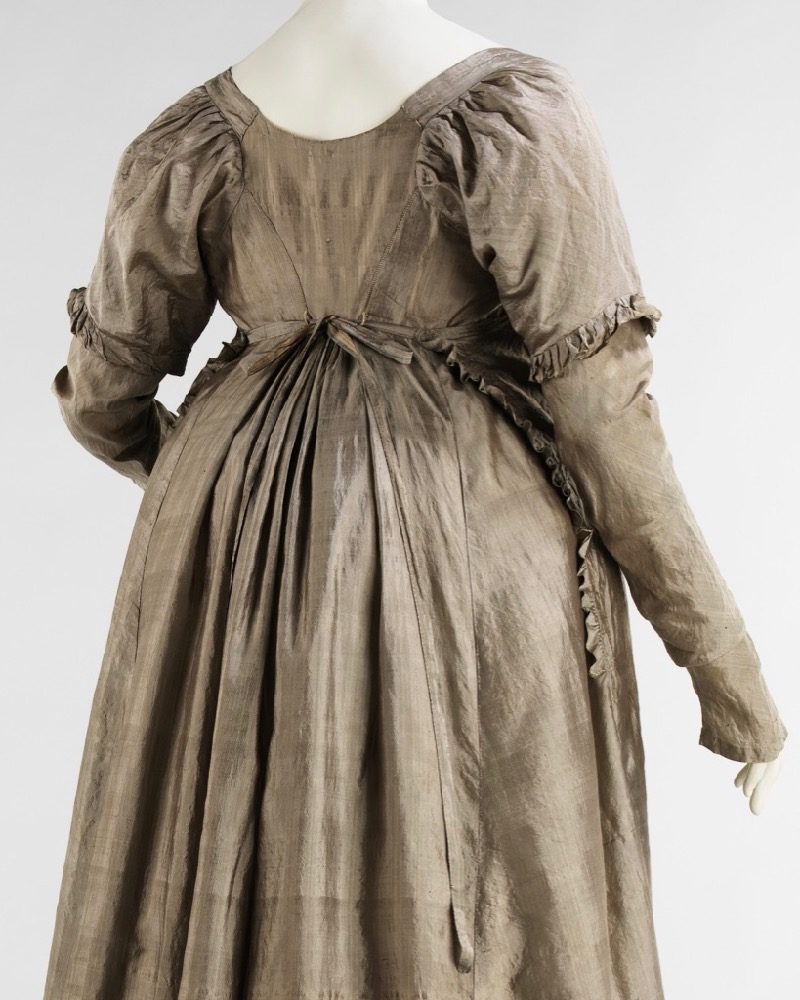
What do you think?
Do you like the pairing of the single darker colour (whatever it was) with the fashionable Empire silhouette, and the small details?
Rate the Dress on a Scale of 1 to 10
A reminder about rating — feel free to be critical if you don’t like a thing, but make sure that your comments aren’t actually insulting to those who do like a garment. Phrase criticism as your opinion, rather than a flat fact. Our different tastes are what make Rate the Dress so interesting. It’s no fun when a comment implies that anyone who doesn’t agree with it, or who would wear a garment, is totally lacking in taste.
(as usual, nothing more complicated than a .5. I also hugely appreciate it if you only do one rating, and set it on a line at the very end of your comment

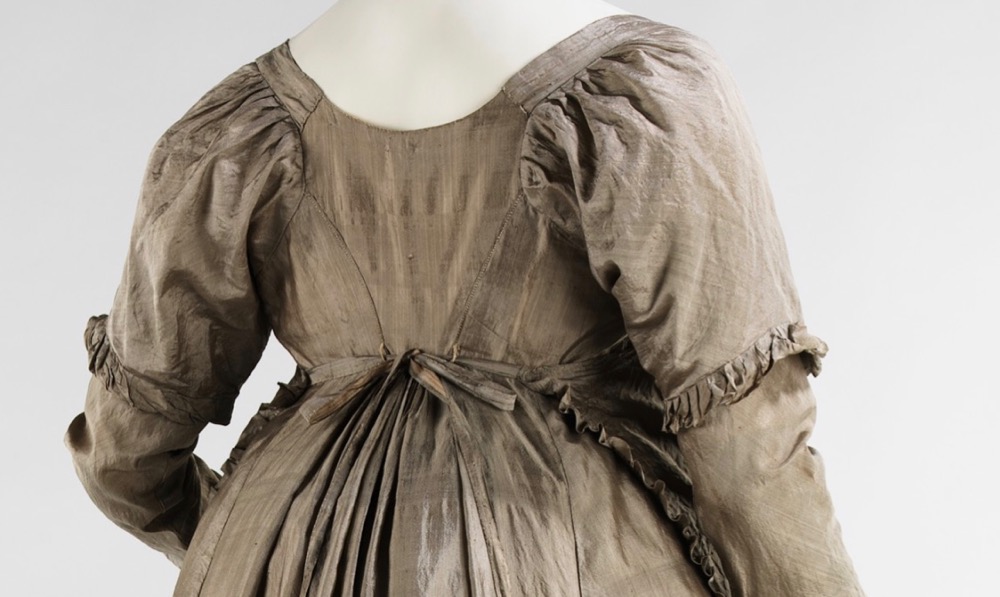
I’ve never seen a train on a dress of that exact shape before! Very interesting.
I like the styling of this dress completely–the simple neckline, long sleeves, and plain bodice, enhanced only by self ruffles. I do not care for its current color, but we don’t know for certain whether that shade of light concrete is due to aging or original. Unfortunately that makes it harder for me to rate it, since color is one of the primary things I consider in rating a costume.
Let’s just say 6.5 out of 10.
Although I generally like the simplicity and comfort level of this era, I find this one has an overall lumpy appearance (although that’s likely just because of how old it is, and how carefully they have to handle it). I do not care for the train design – to me it looks like someone had to chop part of it off because too many people stepped on it.
Definitely hard to evaluate what the color might have been.
7.5 of 10
Other than the color, I think the shape and simple details of this dress are lovely (I prefer that style vs the obvious furbelows of the Victorian era). This would be beautiful, if the color was a deep rich blue, or iridescent bronzy brown.
8/10
i like the little details very well—the precisely gathered pleats at the back waist, the scalloped neckline, the very restrained ruffles here and there. i am not a fan of the squared train, preferring them rounded. i don’t mind the colour; i wish i could see it in person, to see if the silk fabric had more interest born of the play of light on it. as it is, although certainly not obnoxious in any way due to the restraint in colour (mouse dun) and minimal ornamentation, it does seem perhaps a trifle, er, dull? if the silk has in reality a good lustre, it might add significantly to the appeal of this dress. or perhaps it might have been worn with really racy accessories: a bold paisley shawl and unusual jewellery, a striped silk sash a la turque, or a heavily ornamented spencer or redingote? regency accessorising could be quite fun. or perhaps it did in fact fade…i have seen a cloak from the mid-1800s that began its life a rich purple but faded to a colour very like this dress.
so if the previous dress was a bit like “throw everything at it and see what sticks”, this one is in the “modesty is a virtue” camp. one too much, the other perhaps too little. but definitely a relief for the sartorial view compared to the last. as far as a rating, i would have to go with a 5… there is nothing especially wrong with it, but nothing very winning either, so right in the middle.
I quite agree with you; bold but tasteful accessories would do a lot for this dress. But as it is….it is too easily forgettable. I wonder if it was a shot silk that faded? What appears to be the remains of striping suggest that, to me.
Lumpy, frumpy, and dull. I had a navy blue bathing suit turn that color after one swim in the YMCA pool.
I quite like this one from the back. The pleats at the waist and the shape of the sleeves and bodice are lovely from this angle. The only thing I don’t like is the colour (which I can overlook since it may be faded rather than intended) and the square shape of the train. From the front, I don’t like anything. The silhouette is kind of frumpy and the I don’t like the ruffles or the bodice.
5/10
I like the simplicity and grace of this dress, although like Emma I think the back is better than the front. I don’t mind the color, especially knowing this may not have been the original color. I don’t care for the squared-off train. Very nice, but not great. 6.5/10
I, too, like the back of the dress better than the front. Especially the way the sleeves are set into the yoke. But I agree the shape of the train looks like it was stepped on one too many times. My mind’s eye sees the color as a muted sage green (green is my favorite color) so the color doesn’t bother me. More puff to the upper sleeve, please. I would like to see it in person to study the detail. 7/10
Sage green would be quite pretty.
Dullsville…5/10
Restful on the eyes, yes , not sure about the colour though. As a rich blue or purple it could look OK , but seeing it as it is…..
Wonder if the shape of the train was intentional or did the wearer have a mishap ?
Have to give this one a 5
I agree that the colour is probably faded, it could have been purple or mauve, maybe black although it would be more greyish then, difficult to say although the original colour may be inside somewhere where it hasn’t been exposed to the light. I don’t think it would have been this colour ‘drab’ especially on silk. But I used to dye with natural dyes on silk and have seen faded colours from logwood, which start off a mauve shade. Shame we can’t see inside it. But we can’t. I like the style but not sure about the train.
So imagining it in a mauvey lilac shade
6/10
Argh, this dress frustrates me.
The color is neither here nor there. I HATE how the apron looks on the front, but I like the details on the back.
The back is lovely, but the front looks off balance.
I love the sleeves, but hate the squared off train, it feels off.
3/10 because it’s annoying me
I love this dress, and I may be one of the few who also loves the color. I picture someone with a very creamy-ivory complexion and dark hair and eyes wearing it. I like some of the other ideas about colored accessories but could also see pearl or cut-steel jewelry as beautiful and elegant touches with it. It’s not my favorite period–I would not look good in this style–but I try to judge the dresses by their own era. I think the unusual train echoes the front lines of the skirt and the neckline, and it also lends a formality to the dress. The ruffles add just enough softness to the otherwise sober lines. I think the dress as shown suffers a bit, too, from the rumpled fabric and slightly off-kilter display. 9.5
I hate the overall appearance of the dress – the combination of plain shape and frills on sleeves and blouse somehow makes it look overly fussy to me – but I love the idea of the frill on the apron front sides – that’s a lovely little detail.
4/10
It’s simple and elegant which is one thing I love about this style. Not too much going on but enough to keep things interesting.
The fabric is absolutely gorgeous too. I love the slight sheen that catches the light. I’m imagining this in a gunmetal blue and I want it.
There are a few details niggling at me however. The slightly off center front is the biggest issue for me. I wonder if it’s mounted a bit off, or maybe the lady it was made for was a little bit crooked and the mannequin is not. I’m not sure about the colour either. I do like it but on this dress it says gunny sack to me, which the dress certainly is not. I find the square train a bit odd; maybe I’m boring but I think garden variety regency dresses are more my thing. And finally the sleeves. I seem to have read somewhere that overlong sleeves were fashionable, but I find it looks just a little frumpy on this dress. I like the length but not the wrinkles.
I find the slight bustle effect at the back interesting. I can’t recall right now but are all regency dresses so poofy in the rear?j
So hard to decide. I think it’s going to get 7/10
I suspect that this gown was made for an older lady–something about the shaping of the bodice area over the breasts and the way the skirt falls right below the bodice suggest that to me. That suggests, but of course does not confirm, that the dress originally was a darker, bolder color. And it could be consistent with the wearer not being of a symmetrical figure, too.
I love this dress although the colour isn’t great. I like the gathering and the ruffles on the bodice front, likewise the sleeve ruffles, and the side ruffles on the apron are a lovely unexpected detail. The back view is beautiful. The fullness and gathers of the skirt, the bodice seamlines, the scoop of the neckline, the gathering and set of the sleeves, the tie at the back. It all looks soft, full and rich. The small triangular side back panel is really interesting. It looks like it’s not attached at the bottom and I’m really curious about whether it’s constructed that way or just come loose. The squared off train is a bit weird. It doesn’t seem to match the softness of the rest of the dress, and the sleeves are too long for the mannequin. However they are bias cut so perhaps if the dress was worn by someone with fuller arms they’d look better. I’m imagining this dress in a better colour, maybe a lovely green, and its definitely a dress I’d love to wear. The silk fabric looks very like some modern silks I’ve seen and I imagine this dress would be light, floaty and comfortable to wear.
I love it and I totally want to recreate it so its a 9.5/10
This dress is talking to me and I think I have a crush on it. Would love to make it. The details are handsome, even the regal squared train, which reminds me of Empress Josephine.
The color is gorgeous, the color of hemlock tree bark, somewhat mossy in the woods, when it’s wintertime. The sheen makes it — if it were matte I’d be put off entirely.
Deep colors, claret and dark cocoa, would go well, or a cashmere shawl with a touch of yellow and blue in the pattern. Or cream-colored accessories. As another writer noted, cut-steel jewelry or pearls would work beautifully with it.
The only feature I am not fond of is due to the mounting on the mannequin, and that is the extensive padding on the backside. Two little pads on the back of the stays would give a little oomph there, but this is too much. Still, it can’t affect the rating since it’s not part of the dress.
8 of 10
There’s something bohemian and modern about this dress, with its overlong sleeves, cinched-sack silhouette, and bronzed-gray industrial shade. Fitting that it would be housed in the Brooklyn museum, then. I think it looks best with long sleeves, but I would comfortably wear it with short sleeves. I like that it converts. The current color distracts me– I can’t see the romantic sensibility that this dress was surely meant to evoke. It’s alright, though. I like it better out of time or era.
7/10
It is an okay dress, but I don’t find it very special. The small frills are quite sweet and I also rather like the pull tie/bow at the back but I also find the squared off train a bit awkward. The overall look is modest and comfortable.
5/10
Well I’m a huge fan of Regency dresses and a huge fan of this dress. The skirt from the front does look a bit solid and lumpy – but I think that is because it is on a mannequin and has photographed that way. In reality, the train will have pulled that skirt back as the wearer walked along. The details are beautiful, love the clever short to long sleeves, and I think that probably was the original colour. Originally I thought I should take points off for the way the skirt of the dress looked from the front. But, given that it’s likely because of the way it’s displayed, I’m not going to. Dresses and garments, after all, are not created to be static things, they are meant to be worn. So I am giving it the benefit of the doubt.
10/10
I like it. It gives me a Quakerish vibe, even if the colour was originally something else – even with the ruffles (Gay Quakers weren’t adverse to little touches like that). I could also see Jane Eyre wearing this dress (if we bear in mind that Jane Eyre was actually intended to be set in c.1800 rather than contemporary to the 1840s, as so many adaptations and readings assume).
But it is also a wee bit too muted and unmemorable, so I give it a 7/10.
Although not a favorite of the train the empire waist is timeless. It has been present in all generations. The neckline is just enough to be called sexual at the time. The dress in different fabric would produce a beautiful wedding gown. It is also a dress that can conceal weight or pregnancy. As being in a motherly way was considered private in the 1800’s. Bright colors were considered impractical and only for special occasions.
10/10
I am long waisted so the Empire silhouette appeals to me. The square train is an interesting detail; the dress would have been just as lovely without it. I give the dress an 8/10.
I like the the movement in the dress. Modest in style yet versatile in design. Color at this point doesnt interest me as much as the design provided for lots of movement in the shoulder and upper arm areas. The versatile design of the sleeves to be worn long or short. The material silk instead of wool. The sides design with the apron effect. The square train instead of a round one. Much thought was given in the design of this dress. Most likely a well practiced seamstress who knew the client well designed this dress specifically for the versatile needs of her client. I love the figure flattering Empire waist of this era. I’ve worn many a formal in my young years with this design and loved the effortless feel of this particular design and how it flowed on my body. Mind you these are my opinions and my experience with wearing such gowns. To each his/her own opinions!
Love, love, love it. Simplicity at it BEST.
I’ve never seen a square train.
I like it all except the color and I do wish train wasnt square but the dress in its day would have been beautiful I am sure 7 out of 10